 Amandus D. Moyer
Amandus D. Moyer
Posted on Wednesday, January 10, 2018
Categories:
Trucks & Delivery
|
History
The Commonwealth of Pennsylvania is rich in a variety of
natural resources which have most certainly played a key role in the growth and
development of the state and of the world over the decades. In fact, over the
past two centuries, Pennsylvania has been a world leader the production of
steel, coal, coke, cement and lumber.
When Pennsylvania was settled, it’s believed that her
grounds were 90% covered by forest. White pine, eastern hemlock and assorted
hardwoods grew abundantly and were harvested in large numbers to support the
population spread of settlers westward off of the east coast. Water-powered saw
mills supplied the massive appetite for new lumber in construction projects
across the region starting in the 1800s.
In the 1860s Pennsylvania led the nation in lumber
production, but by 1900 it had dropped to fourth. During that period,
Williamsport's log boom on the Susquehanna had been the world's largest lumber
pile.
By the 1920s, a majority of the old-growth forests in
Pennsylvania had been depleted, prompting the Commonwealth to purchase
thousands of acres of land from lumber companies and begin to regulate and
reforest the landscape. This gave birth
to the modern conservation movement and continues to influence modern-day
forestation practices in the industry.
So now that we know all is well with the Pennsylvania
forests and that her hardwoods are, once again, plentiful and in demand
worldwide, let’s take a look at how lumber delivery has evolved over the
centuries.
1800s Lumber Delivery
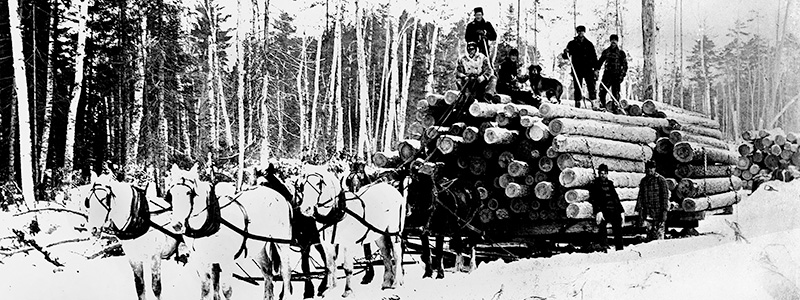
By the 1790s, New England was exporting 36 million
board feet of pine boards and 300 ship masts annually. As the availability of
adequate trees diminished in the far Northeast, Pennsylvania’s tall and true
white pine and hemlock trees were in high demand for these masts. Movement of
lumber from one point to the next on land was accomplished by horse-drawn
wagons and via the railroad after 1830.
Pennsylvania’s large and numerous rivers provided for
massive floating log rafts to move thousands of trees to the water-powered sawmills. Sawn lumber was then loaded on barges to
continue down river, and on carriages and rail cars for transport over land.
Early 1900s Lumber
Delivery
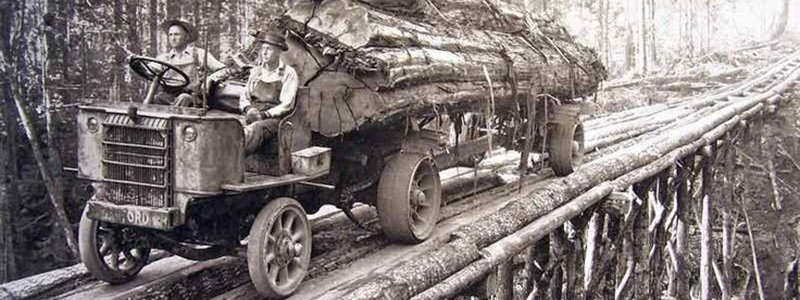
In Pennsylvania and the rest of the nation, the industrial
revolution rode on American rails.
Trains carried coal and lumber to consumers quickly and cheaply. The invention
and popular rise of the automobile in the early 1900s rapidly changed the way
Americans moved themselves and their cargo. Trucks of the era mostly used two-cylinder internal-combustion
engines and had a carrying capacity of 3,300 to 4,400 pounds. In 1904, 700
heavy trucks were built in the United States, 1000 in 1907, 6000 in 1910, and
25000 in 1914.
Lumber delivery even played a part in the prohibition era with some very creative disguises to smuggle alcohol.
Hydraulic Hoists in
Lumber Delivery
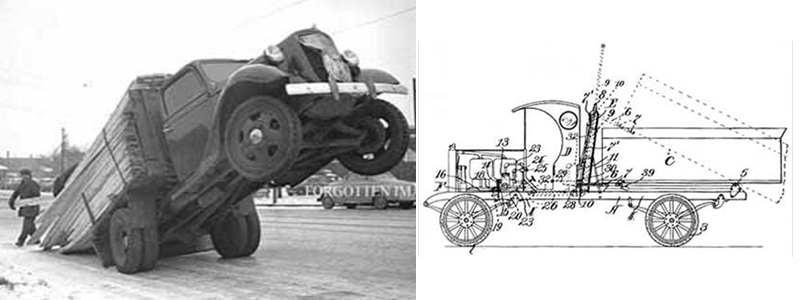
Prior to the invention of the hydraulic lift on trucks, dump
beds were available but required a brutal 30-minute process of hand cranking
the bed high enough to cause the cargo to slide off of the bed of the truck. The
invention of the hydraulic hoist on truck dump beds by Gar Wood around 1915
changed the delivery industry dramatically. Well after the invention but before
trucks were widely equipped with hydraulic dump beds, creative lumber truck drivers
would travel in reverse at high speed and slam on the brakes, shifting the load
backward and raising the entire front of the truck off of the ground. They
would then drive out from underneath the partially-dumped load, slamming the
front of the truck back to the ground when the load released.
Post World War II in
Lumber Delivery
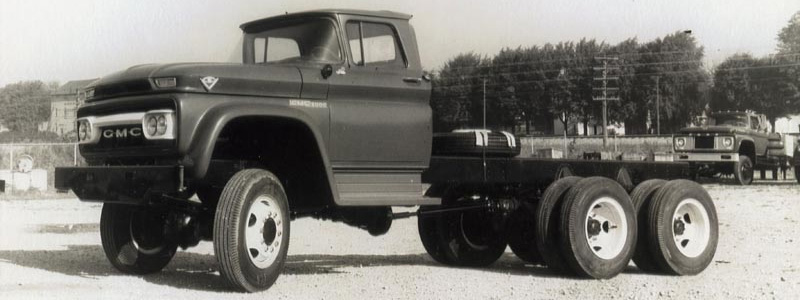
World War II played a large part in inspiring American
mechanics and machinists to new heights. Post-war inspirations gave us the Harley-Davidson
Sportster in 1957 along with the ’57 Chevy. Many post-war inspirations in trucks
also arose. Soldiers returning from war had learned their vehicles inside and
out and dreamed of all that they could accomplish back at home. Vehicles like
the Willys Jeep which played a huge role in winning the war, became the first
4-wheel drive vehicle to be manufactured in six-figure numbers. Additional multi-axle and higher clearance post-war inspiration was introduced to the domestic delivery truck which continued to grow in size, capacity.. and demand.
Interstate Highways in
Lumber Delivery
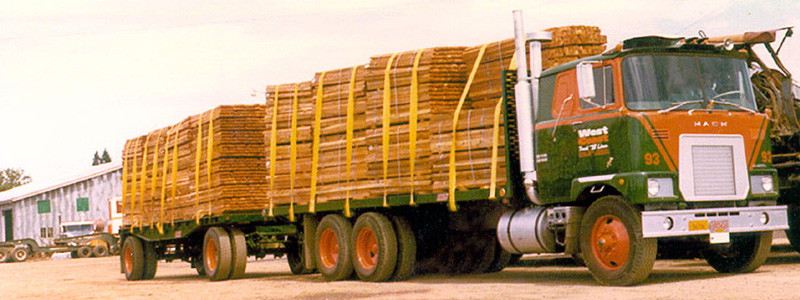
The Federal-Aid Highway Act of 1956 authorized
the construction of the Interstate Highway System, an interconnected
network of controlled-access freeways that allowed larger trucks to travel at
higher speeds through rural and urban areas. This act also authorized the first
federal maximum gross vehicle weight limits for trucks, set at 73,280 pounds.
The Federal-Aid Highway Amendments of 1974 established
a federal maximum gross vehicle weight of 80,000 pounds, and introduced a
sliding scale of truck weight-to-length ratios based on the bridge formula, but
did not establish a federal minimum weight limit. The decade
of the 70s saw the heyday of truck driving, and the dramatic rise in the
popularity of "trucker culture". Truck drivers were romanticized as
modern-day cowboys and outlaws, a stereotype that persists even today.
Big rigs littered the highways, carrying lumber and America’s
daily-growing cargo demands across the nation.
Modern Day Lumber
Delivery
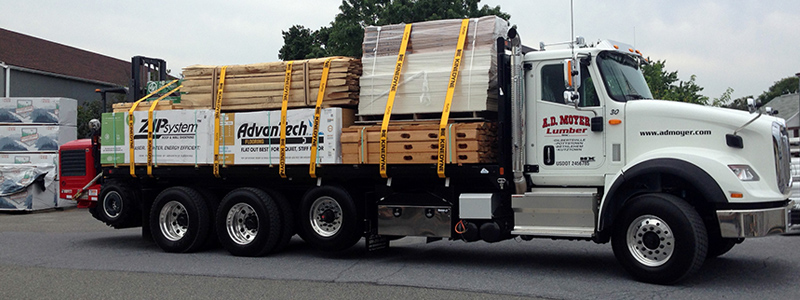
By 2015 there were over 31.4 million trucks on America's
roads, hauling 10.5 billion short tons of freight annually, representing
nearly 70.1% of the total domestic tonnage shipped in the United States. Lumber delivery drivers now benefit
from tilt split flatbeds and multiple axles including a lift axle which can be raised or lowered as the operator needs, increasing their operating capacity. Added truck-mounted accessories including the knuckle boom crane and the
Moffitt forklift are also common. These features permit
drivers to do far more than just dump the load which can lead to damage of
property and materials depending on the circumstances. Cranes and forklifts provide the diversity to easily lift
and carefully place the load in areas where the truck cannot fit, including upward.
Rooftop delivery and delivery to floors above ground level are now a daily occurrence
without a second thought for the modern lumber delivery driver.
The modern-day railroad continues to play a key factor in getting
the timber to the lumberyard, shipping 24 million tons of lumber and wood products annually. Rail delivery enables Pennsylvania lumber buyers
to bring in loads totaling tens-of-thousands of board feet from mills in Canada
and the Pacific Northwest.
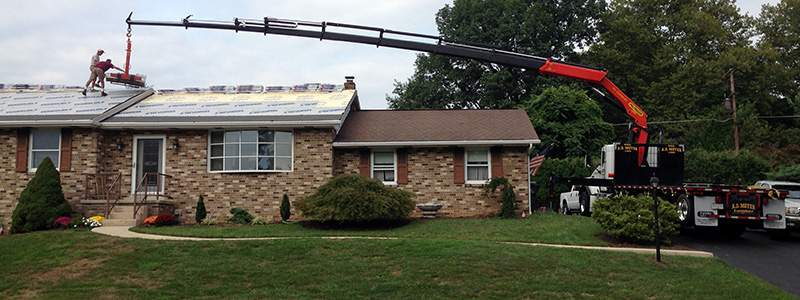
[Resources] Pennsylvania Lumber Museum, American Trucking Association, Philadelphia Reflections, Historic Building Materials & Methods, Statista, Wikipedia, Britanica, Popular Mechanics
Tagged:delivery, lumber, Pennsylvania, trucks, history, nostalgia